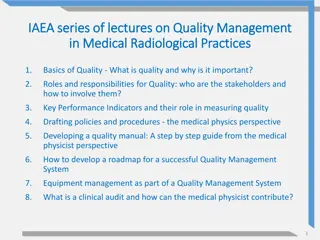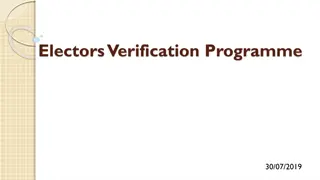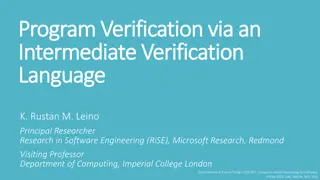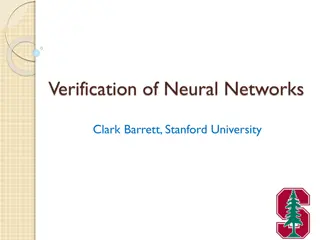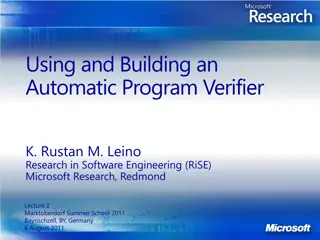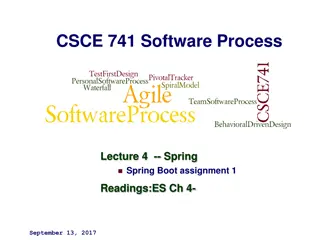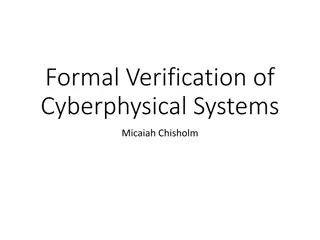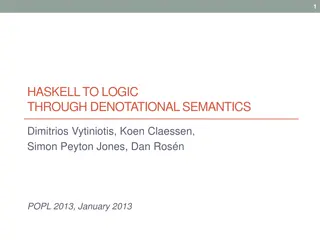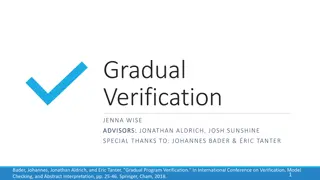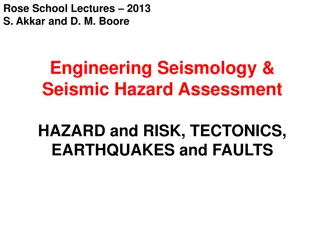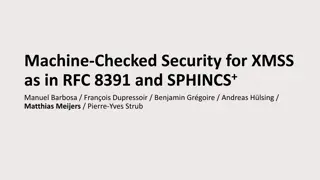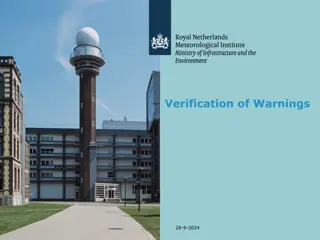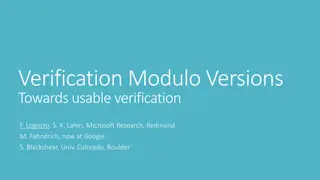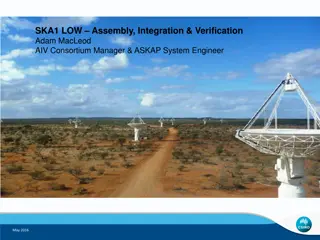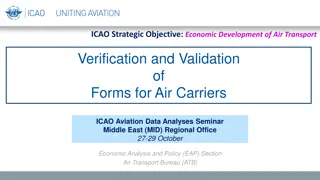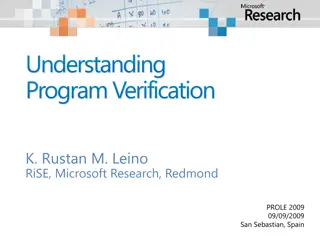Understanding Verification Methods in Spring 2022 Tufts University Lectures
Explore the lectures by Joel Grodstein and Scott Taylor at Tufts University focusing on verification methods, including self-checking tests, cycle-by-cycle comparison, and the importance of getting the correct data and timing. The lectures discuss the challenges of ensuring correctness in designs and implementations, offering insights into effective verification strategies.
Download Presentation

Please find below an Image/Link to download the presentation.
The content on the website is provided AS IS for your information and personal use only. It may not be sold, licensed, or shared on other websites without obtaining consent from the author. Download presentation by click this link. If you encounter any issues during the download, it is possible that the publisher has removed the file from their server.
E N D
Presentation Transcript
Verification Spring 2022 Tufts University Instructors: Joel Grodstein, Scott Taylor Checking correctness 1
Outline of this lecture Intro No right time No right answer Reference models Self-checking tests Implementation Verification 2 Joel Grodstein/Scott Taylor
Did your test pass? You run a test Obvious question how do you know if the DUT got the right answer? Let s look at what we did for our FIFO tests Verification 3 Joel Grodstein/Scott Taylor
Scoreboard Verification environment DUT scoreboard (compare ==?) test inputs drivers ref model Same inputs to both models Cycle by cycle comparison Verification 4 Joel Grodstein/Scott Taylor
Good enough? Verification environment DUT scoreboard (compare ==?) test inputs drivers ref model Do you think this approach will be universally useful? Hint this will be a very short lecture, if so! Answer no, it s not Rest of the lecture why not, and what to do about it Verification 5 Joel Grodstein/Scott Taylor
What does correct mean? Come on, this is easy, isn t it? Yes in some cases, definitely Correct means Should get the correct data! Push 0xAB into the FIFO, better not get 0xBA out! Data comes out at the correct time no off-by-one-cycle errors What if there is no correct data? What if there is no correct time? Verification 6 Joel Grodstein/Scott Taylor
Outline of this lecture Intro No right time No right answer Reference models Self-checking tests Implementation Verification 7 Joel Grodstein/Scott Taylor
No right time The mesh it must deliver packets to their destination Do we spec the precise arrival cycle? Cycle-by-cycle compare cannot work Any examples other than the mesh? where the DUT is free to use whatever timing it wants but it has to get the right answer eventually Verification 8 Joel Grodstein/Scott Taylor
Really, no right time! Branch prediction Does BP change the final output of a program? will a bug in the BP change the program output? So how can you verify that the BP is working? What state or timing does BP change? LD r1=MEM[r2] BZ L1 ADD r4=r5+r6 L1: SUB r4=r5+r6 LD BZ ADD SUB F D F EX D F MEM EX D WB MEM EX WB XX F D Verification 9 Joel Grodstein/Scott Taylor
Reset How do you verify reset? It s actually quite hard! Any thoughts why? Most nodes power up as X Chip must reset to enough of a known value that subsequent execution works Reset must typically happen within a certain time period, but no exact spec Something to think about Verification 10 Joel Grodstein/Scott Taylor
Outline of this lecture Intro No right time No right answer Reference models Self-checking tests Implementation Verification 11 Joel Grodstein/Scott Taylor
What does correct mean? Come on, this is easy, isn t it? Yes in some cases, definitely Correct means Should get the correct data! Push 0xAB into the FIFO, better not get 0xBA out! Data comes out at the correct time no off-by-one-cycle errors now for this one we just did this Verification 12 Joel Grodstein/Scott Taylor
No right value What if the DUT doesn t spec the correct data? Can you come up with any meaningful examples of this? what use is a system that doesn t have a correct answer, anyway? engineers like our problems to have a right answer! In fact, many such examples Liberal-arts majors will be happy today Verification 13 Joel Grodstein/Scott Taylor
Multithreaded code thread #1 thread #2 store mem[1000]=3 store mem[1000]=4 What is the end-of-test value of mem[1000]? Fundamental issue threads can execute in arbitrary order Most architectures make no guarantees Verification 14 Joel Grodstein/Scott Taylor
Multithreaded code thread #1 thread #2 store mem[1000]=3 store mem[1000]=4 Room-change announcement 1. First write room_location, change Halligan 102 111 2. write an e-mail to the class what if the class sees the e-mail before the room-change write? Memory coherency all cached copies of a memory location have the same value consistency ordering of two accesses is seen identically by all threads all CPUs, no GPUs some CPUs Short exercise: does ARM guarantee you see the correct room? https://devblogs.microsoft.com/cppblog/hello-arm-exploring-undefined- unspecified-and-implementation-defined-behavior-in-c Verification Joel Grodstein/Scott Taylor 15
But what to do? thread #1 thread #2 store mem[1000]=3 store mem[1000]=4 What to do about multi-thread issues? Only write single-threaded tests Write very careful multi-threaded tests with only one answer Analyze your multi-thread tests & accept any reasonable answer Pros and cons of each? Bottom line RCG for a multithreaded memory system is hard! Verification 16 Joel Grodstein/Scott Taylor
Error handling Pick your favorite HW project from the last few years Did the assignment spec your project s response to input data? To incorrect inputs? Commercial projects are better not always perfect some chips specifically specify that certain results are unspecified! fun task search for the term Implementation defined in the ARM Architecture Reference Manual or learn what Imprecise exceptions are How can you handle these cases? hopefully sometimes Verification 17 Joel Grodstein/Scott Taylor
Still more Can you think of any examples where there isn t just one right answer? CPU with imprecise exceptions no guarantee which instructions complete after an exception happens Any other examples? Verification 18 Joel Grodstein/Scott Taylor
Outline of this lecture Intro No right time No right answer Reference models Self-checking tests Implementation Verification 19 Joel Grodstein/Scott Taylor
But Verification environment DUT scoreboard (compare ==?) test inputs drivers ref model DUT may not have a single right answer, known time Two approaches make the reference model more flexible self-checking test doesn t use a reference model Now Next Verification 20 Joel Grodstein/Scott Taylor
Reference models Three categories of reference models Cycle accurate like our FIFO model End-of-test accurate model gives you the desired answer no idea when it will show up! check results at end of test Transaction accurate compromise try to check each transaction as it occurs Easy Next And then Verification 21 Joel Grodstein/Scott Taylor
End-of-test mesh checking Verification environment DUT scoreboard (compare ==?) test inputs drivers ref model Start with our favorite example the mesh We can observe the incoming packets How would you spec the end-of-test check? Verification 22 Joel Grodstein/Scott Taylor
OOO CPU Next example an OOO CPU instructions launch in program order instructions execute in dataflow order instructions retire in program order Few guarantees about execution order Exercise spec out your end-of-test CPU check like we did for the mesh Verification 23 Joel Grodstein/Scott Taylor
End-of-test checks End-of-test checks look easy! Because we haven t looked very hard yet No free lunch Verification 24 Joel Grodstein/Scott Taylor
When are we done? We said check values at the end of the test but how do we know when the test is ended? how many cycles do we wait? Strategy just wait a really really long time Problems? just how long is that anyway? now every test is really slow Verification 25 Joel Grodstein/Scott Taylor
OOO CPU What makes a CPU test take a really long time? cache misses can cause long delays paging is far worse Any way to not wait 1M cycles after every test? monitor the cache-miss signals only wait the max if there is indeed a cache miss lots more signals we can look at; any ideas? Works fine. Any cost to it? test environment must be more sophisticated must adapt to signals in the DUT Verification 26 Joel Grodstein/Scott Taylor
When is the mesh done? Back to the mesh again Spec no fixed interval for a packet to reach its output So again how do we know when the test is done? Some ideas: wait until the inputs have stopped for a while, and we ve observed as many output packets as input packets wait until all FIFOs are empty Take a few minutes and try to poke holes in these ideas Often the test will write an agreed-upon register when it s done (e.g., has written all packets to the mesh) would this change the effectiveness of the two ideas above? Verification 27 Joel Grodstein/Scott Taylor
Legally waiting forever? Further discussion Does Comcast spec how long you will ever wait for packet transmission? If your max interval is only probabilistic, how do you pick the timeout length? What will happen when a legal test case exceeds your chosen timeout length? Observation: pick TIMEOUT too short will have to manually debug some tests will give you insight into what makes your system slow will take lots of debug time! Verification 28 Joel Grodstein/Scott Taylor
More no free lunch End-of-test checking is great, except not always easy to know when the test is ended and Verification 29 Joel Grodstein/Scott Taylor
OOO CPU OOO CPU strategy summary Run the whole program Wait the smart-timeout number of cycles Check for correct values in all registers, memory Seems reasonable? Consider this program What if the DUT has a bug the first load to any reg is dropped will we catch it with this program? how can we catch it at all? load R5=6 load R5=5 Verification 30 Joel Grodstein/Scott Taylor
More no free lunch End-of-test checking is great, except not always easy to know when the test is ended and you may lose test sensitivity and debugging is a PITA Why is end-of-test debug so ugly? because the bug probably happened a really long time ago walking backwards 1M cycles is not fun at all Verification 31 Joel Grodstein/Scott Taylor
Making debug easier Find failures sooner debug is easier But how do you do that? Lots of assertions pipeline data moves along correctly mux controls are exclusive & match high-level transaction whatever else you can think of! but careful not to rewrite the entire model in the assertion! Verification 32 Joel Grodstein/Scott Taylor
Livelock/deadlock Remember what these are? Deadlock: A waits for B, B waits for A, nobody moves Livelock: everyone moves but just in circles Fun diversion can you write examples of each? Should the verification environment detect these? How can it? Look for endless loops of the same few instructions Look for a lock instruction that repeatedly fails draw out a picture of these cases Verification 33 Joel Grodstein/Scott Taylor
Faster mesh failure Verification environment DUT FIFO scoreboard (compare ==?) FIFO test inputs ==? drivers ref model We want to find failures faster Does this work? ref model delivers packets instantly scoreboard queues up inputs in a FIFO keep checking all DUT outputs for a match remove packet from SB FIFO when it matches Verification 34 Joel Grodstein/Scott Taylor
Mesh test v2 Rules to check packet must get to the correct destination must take at least 1 cycle must take less than TIMEOUT cycles Checking algorithm store copies of the packets that have launched. when a packet arrives anywhere, check that it was sent & mark the original packet as received. stop the sim TIMEOUT cycles after the final packet launch confirm that all packets were received Does this work? How is it better than end-of-test checking? Brainstorm: how can we make our checking even tighter? Verification 35 Joel Grodstein/Scott Taylor
Reference models Three categories of reference models Cycle accurate like our FIFO model End-of-test accurate model gives you the desired answer no idea when it will show up! check results at end of test Transaction accurate compromise try to check each transaction as it occurs Easy Just talked about this And wound up sort of talking about this Verification 36 Joel Grodstein/Scott Taylor
Reference model summary When are cycle-accurate models practical? worked fine for our FIFO and for other very simple chips or for a verifying one small piece of a larger DUT And when they re not check as much as you can as soon as possible after it happens check the rest at the end of the test (but it will be hard to debug and may miss overwrite cases) Verification 37 Joel Grodstein/Scott Taylor
Outline of this lecture Intro No right time No right answer Reference models Self-checking tests Implementation Verification 38 Joel Grodstein/Scott Taylor
Reference models Verification environment DUT scoreboard (compare ==?) test inputs drivers ref model DUT may not have a single right answer, known time Two approaches make the reference model more flexible self-checking test doesn t use a reference model Now Next Verification 39 Joel Grodstein/Scott Taylor
What if we dont know No right time checked at end of test or sooner What about no right data? How might we check for this within our strategy of checking against a reference model? Have the reference model return an X? New idea a self-checking test decides pass/fail by itself doesn t need a reference model to compare to! But how can that be? Verification 40 Joel Grodstein/Scott Taylor
Reversi Reversi is an environment to verify CPUs Observations How much is 4+3-3? Clearly 4 How much is 4+x-x? Still 4, independent of x Yeah, so what? Reversi strategy to verify add, subtract: load all registers with random values, remember what they are create instructions to add a random value from any register, subtract the same one randomly reorder those instructions run the test check the the register values haven t changed Don t need a reference model! make a nice animation Verification 41 Joel Grodstein/Scott Taylor
Reversi Clever? Sure, but there s a lot more to testing a CPU than just add/subtract? Could it work for floating-point add/subtract? Only if you accept a close-enough answer really not great Floating-point mpy/divide? Load & store? Branches? Does it fix our problem of what to do for undefined results? Verification 42 Joel Grodstein/Scott Taylor
Outline of this lecture Intro No right time No right answer Reference models Self-checking tests Implementation Verification 43 Joel Grodstein/Scott Taylor
Strategy & implementation We ve talked a lot about what to do Next up some implementation details which parts of our testbench do what, and why? it s all about minimizing work: reuse, software layers monitor checker high- level stimulus driver DUT monitor checker high Verification 44 low Joel Grodstein/Scott Taylor
Monitors A monitor does observes data packages it for consumption abstracts bits signals transactions A monitor does not do the checks monitor checker high- level stimulus driver DUT monitor checker Verification 45 Joel Grodstein/Scott Taylor
Checkers A checker does take abstracted data from a monitor do the actual checks may include assertions, instantaneous checks, pipeline checks (built up over time) A checker does not do the data abstraction monitor checker high- level stimulus driver DUT monitor checker Verification 46 Joel Grodstein/Scott Taylor
Layered system Why bother with two layers? the usual reasons! allow people work productively without knowing the entire system allow reuse of checkers even if implementation changes simplify via reuse one monitor can feed multiple checkers high- level stimulus monitor checker driver DUT monitor checker Verification 47 Joel Grodstein/Scott Taylor
Ref model Where do we put a reference model? Do we want it to be at a high or low level? ref model ref model monitor checker high- level stimulus driver DUT monitor checker Verification 48 Joel Grodstein/Scott Taylor
Ref model Where do we put a reference model? Do we want it to be at a high or low level? ref model scoreboard monitor high- level stimulus driver DUT monitor checker Verification 49 Joel Grodstein/Scott Taylor
Ref model Where do we put a reference model? Do we want it to be at a high or low level? scoreboard ref model monitor checker high- level stimulus driver DUT monitor checker Verification 50 Joel Grodstein/Scott Taylor


